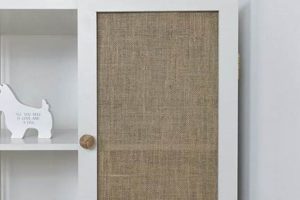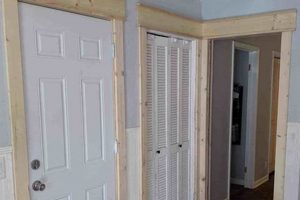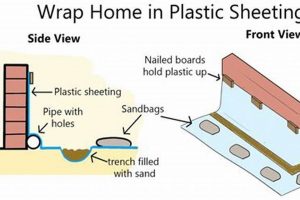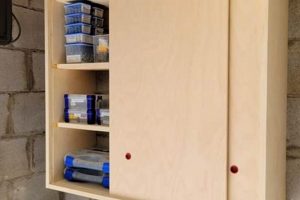Constructing bypass access for enclosed storage spaces through personal fabrication involves careful planning and execution. An example includes replacing traditional hinged access points on kitchen units with panels that glide horizontally, maximizing space and offering an alternative aesthetic.
This approach offers advantages such as improved spatial efficiency, particularly in confined areas where swinging doors may obstruct movement. Historically, adapting existing furniture has allowed homeowners to personalize their living spaces and reduce costs compared to purchasing new, specialized units. Furthermore, the process promotes resourcefulness and skill development.
The subsequent discussion will address essential aspects of this project, covering material selection, hardware requirements, step-by-step construction techniques, and crucial safety considerations.
Guidance for Cabinet Sliding Door Creation
The following provides actionable advice for those undertaking the construction of horizontally traversing access panels for storage units. Adherence to these guidelines enhances project success and longevity.
Tip 1: Precise Measurement is Paramount: Before commencing any physical construction, meticulously measure the cabinet opening. Account for track hardware dimensions and desired panel overlap to prevent gaps or binding.
Tip 2: Material Selection Influences Performance: Choose materials suited to the intended environment. Solid wood offers durability but can warp; MDF provides stability but requires sealing; lightweight options like acrylic reduce stress on hardware.
Tip 3: Hardware Quality Dictates Smooth Operation: Invest in high-quality track systems and rollers designed for the weight and size of the panels. Cheap hardware often leads to premature wear and operational difficulties.
Tip 4: Ensure Panels are Square and Flat: Prior to installation, confirm that each panel is perfectly square and flat. Warped or uneven panels will not glide smoothly and may damage the track system.
Tip 5: Implement Soft-Close Mechanisms: Consider integrating soft-close mechanisms to prevent slamming and reduce wear on the panels and frame. This addition enhances user experience and prolongs the lifespan of the assembly.
Tip 6: Proper Alignment is Critical During Installation: When installing the track, ensure it is perfectly level and aligned. Misalignment will cause the panels to bind or derail. Use a level and shims as needed.
Tip 7: Finish Application Impacts Longevity: Apply a durable finish to protect the panels from moisture, scratches, and UV damage. The selected finish should be compatible with the chosen panel material.
Implementing these considerations ensures a functional and aesthetically pleasing outcome. Accuracy, quality materials, and careful assembly are essential for a successful project.
The subsequent section will address common troubleshooting scenarios encountered during and after the project’s completion.
1. Precise Measurements
Accurate dimensioning constitutes a foundational element in the successful execution of bypass storage access construction. Deviations, even marginal, from prescribed measurements can precipitate a cascade of complications, undermining the project’s integrity. For instance, underestimating the cabinet opening width results in panels too large to traverse freely, necessitating rework. Conversely, overestimation yields unsightly gaps, compromising the aesthetic appeal and potentially reducing the cabinet’s protective capacity against dust and pests.
The significance of precise measurements extends beyond mere physical fit. It directly influences the operational efficiency and the longevity of the sliding mechanism. Mismatched panel dimensions can induce undue stress on the track and roller system, accelerating wear and tear. A real-world example involves a homeowner who, neglecting to account for track thickness, fabricated panels that rubbed against the cabinet frame, requiring complete disassembly and panel resizing. Careful measurement, therefore, not only avoids costly errors but also ensures smooth, reliable operation of the assembly over time.
In summary, accurate dimensioning transcends a simple preliminary step; it is an investment in the project’s overall success. Addressing this aspect with meticulous attention to detail mitigates potential challenges and fosters a durable, functional, and visually harmonious outcome. Overlooking precision, however, risks compromising the entire endeavor, leading to frustration and added expense.
2. Material Selection
The choice of materials fundamentally impacts the functionality, aesthetics, and longevity of bypass access for enclosed storage spaces. Selection criteria extend beyond superficial appeal, necessitating consideration of factors such as durability, stability, weight, and environmental suitability.
- Wood Species and Solid Wood Considerations
Hardwoods like oak or maple provide superior strength and resistance to wear, suitable for high-traffic areas or frequently used cabinets. However, solid wood is prone to warping and expansion/contraction with humidity fluctuations, potentially causing operational problems. Softwoods, such as pine, offer a more economical option but are less resistant to denting and scratching. The appropriate selection depends on the intended use and environmental conditions.
- Engineered Wood Products: MDF and Plywood
Medium-Density Fiberboard (MDF) presents a stable and uniform surface ideal for painting or applying veneers. Its lack of grain prevents warping, but it is susceptible to moisture damage and is heavier than solid wood. Plywood, constructed from layered wood veneers, offers a balance of strength and stability. Its resistance to warping makes it a suitable choice, but exposed edges require finishing or edge banding for aesthetic appeal.
- Acrylic and Alternative Synthetics
Acrylic panels provide a modern aesthetic, are lightweight, and resistant to moisture. However, they are more prone to scratching and may require specialized cutting tools. Alternative synthetics, such as PVC or polycarbonate, offer varying degrees of durability and moisture resistance, suitable for environments requiring chemical resistance or high humidity.
- Hardware Compatibility and Material Weight
The weight of the chosen panel material directly influences the selection of appropriate track and roller hardware. Lightweight materials, such as acrylic or thin MDF, require less robust hardware, reducing costs and simplifying installation. Heavier materials, such as solid wood or thick plywood, necessitate heavy-duty hardware to ensure smooth operation and prevent premature wear. Incompatibility between material weight and hardware capacity leads to operational difficulties and potential system failure.
The interplay between material properties and the chosen hardware system determines the overall performance of the cabinet access point. Informed decision-making, accounting for environmental factors, intended usage, and budget constraints, is crucial for achieving a durable, functional, and aesthetically pleasing outcome. Compromising on material selection can lead to operational inefficiencies, premature failure, and increased maintenance costs.
3. Hardware Quality
The operational efficacy and longevity of bypass storage access solutions depend heavily on the quality of the hardware components employed. Inferior hardware introduces a multitude of potential failures, undermining the overall utility of the system. The track system, rollers, and associated fasteners bear the responsibility of supporting the panel’s weight and facilitating smooth, consistent movement. Consequently, substandard materials or imprecise manufacturing in these components can lead to binding, derailment, premature wear, and ultimately, system failure. An example illustrating this point involves the use of low-grade plastic rollers that disintegrated under normal use, necessitating complete replacement of the entire track system.
Conversely, investing in high-quality hardware, constructed from durable materials and engineered for precise tolerances, provides tangible benefits. For instance, tracks manufactured from hardened steel offer superior resistance to bending and deformation, ensuring consistent alignment and smooth gliding. Rollers equipped with sealed bearings minimize friction and require less maintenance, contributing to extended operational lifespan. Furthermore, the implementation of soft-close mechanisms, often indicative of higher hardware quality, prevents slamming and reduces stress on the panels and frame, enhancing both user experience and the system’s durability. Failure to adequately consider weight ratings and material compatibility between the panels and the hardware can likewise compromise performance.
In summary, hardware quality is not merely a cosmetic consideration, but rather a critical determinant of functionality, reliability, and the overall return on investment in bypass access solutions. Skimping on hardware costs often results in increased maintenance, frequent repairs, and a shortened lifespan for the entire system. Prioritizing quality hardware, even at a higher initial expense, proves to be a more cost-effective and sustainable approach in the long term, guaranteeing consistent operation and minimizing the risk of disruptive failures.
4. Panel Construction
Panel construction represents a critical phase in the execution of bypass access creation for enclosed storage. The dimensions, structural integrity, and surface finish of each panel directly influence the system’s operability, aesthetic appeal, and long-term durability. Improperly constructed panels can lead to binding within the track system, misalignment, and accelerated wear on both the panels and the associated hardware. For example, panels not cut squarely may exhibit uneven gaps when closed, detracting from the overall appearance and potentially compromising the cabinet’s protective function. The accuracy of panel dimensions ensures smooth operation and prevents operational inefficiencies.
The materials used in panel construction further impact the system’s performance. Solid wood panels, if not properly seasoned and sealed, are prone to warping due to fluctuations in humidity. Warped panels hinder smooth gliding and may damage the track system. Medium-density fiberboard (MDF) provides a stable alternative but requires careful sealing to prevent moisture absorption and subsequent swelling. The choice of material and the construction techniques employed should align with the environmental conditions in which the assembly will be used. This consideration minimizes the risk of material degradation and ensures consistent performance over time. The finishing process, involving sanding, priming, and painting or staining, protects the panel surface from scratches, moisture, and UV damage, prolonging its aesthetic appeal and structural integrity.
In conclusion, panel construction is integral to the successful creation of horizontally traversing access panels. Adherence to precise measurements, careful material selection, and meticulous finishing techniques are essential for achieving a functional, durable, and visually pleasing outcome. Neglecting the intricacies of panel construction can result in operational difficulties, premature failure, and diminished aesthetic appeal. The process, therefore, deserves careful planning and execution.
5. Smooth Operation
Smooth operation constitutes a primary objective in the design and implementation of cabinet access points. This characteristic directly influences user satisfaction, system longevity, and overall functional efficiency.
- Track Alignment and Leveling
Proper alignment of the track system is paramount for effortless gliding. Misalignment induces friction and binding, impeding smooth movement. Leveling ensures that the panels traverse horizontally without vertical deviation, preventing uneven wear on rollers and tracks. An example involves a homeowner who, after installing the track with a slight incline, observed that the panels consistently drifted to one side, requiring constant manual correction.
- Roller Quality and Lubrication
The selection of high-quality rollers, equipped with sealed bearings, minimizes friction and promotes consistent, quiet operation. Regular lubrication of moving parts further reduces friction and extends the lifespan of the hardware. Inadequate lubrication results in increased resistance, leading to jerky movements and premature wear. In contrast, well-maintained rollers facilitate smooth, effortless panel movement.
- Panel Weight and Hardware Compatibility
Matching panel weight to the load-bearing capacity of the track and roller system is crucial for optimal performance. Overloading the hardware leads to increased friction, accelerated wear, and potential system failure. Conversely, using excessively robust hardware for lightweight panels can result in less sensitive movement. Selecting hardware specifically designed for the panel weight ensures smooth, controlled gliding.
- Panel Clearance and Overlap
Adequate clearance between the panels and the cabinet frame, as well as the correct amount of overlap between adjacent panels, prevents binding and ensures smooth operation. Insufficient clearance causes friction and resistance, while excessive overlap can hinder access to the cabinet interior. Precision in panel dimensions and careful adjustment during installation are essential for achieving optimal clearance and overlap.
The aforementioned facets contribute directly to the perceived quality and functional lifespan of cabinet access points. By addressing track alignment, roller quality, panel weight compatibility, and panel clearance, a smoother and more reliable operating system is ensured. Therefore, prioritizing these elements translates directly into user satisfaction and reduced maintenance over time.
Frequently Asked Questions
The following addresses common inquiries regarding the construction and installation of horizontally traversing access for enclosed storage spaces. The information provided aims to clarify essential aspects and mitigate potential challenges.
Question 1: What is the optimal material for bypass storage access construction in humid environments?
In environments characterized by elevated humidity levels, materials resistant to moisture absorption are preferred. Medium-Density Fiberboard (MDF) should be avoided unless thoroughly sealed with a water-resistant coating. Plywood, particularly marine-grade plywood, offers enhanced resistance to warping and delamination. Acrylic panels also present a viable option due to their inherent moisture resistance.
Question 2: How does one mitigate the risk of panels derailing from the track system?
Ensuring precise track alignment and utilizing high-quality rollers are critical preventative measures. The track must be perfectly level and securely fastened to the cabinet frame. Rollers should be rated to support the panel’s weight and equipped with mechanisms that prevent lateral movement. Consider incorporating safety features such as end stops to prevent accidental dislodgment.
Question 3: What are the key considerations when selecting hardware for bypass storage access applications?
Hardware selection should prioritize durability, load-bearing capacity, and smooth operation. The track material should resist bending and deformation. Rollers should feature sealed bearings for minimal friction. Weight ratings must exceed the panel’s weight to prevent premature wear. Compatibility between the hardware and the panel material is also crucial. Utilizing soft-close mechanisms offers enhanced user experience and system longevity.
Question 4: How can the risk of gaps between the panels and the cabinet frame be minimized?
Accurate measurement and precise panel cutting are essential. Overlapping the panels slightly beyond the cabinet opening effectively seals gaps. Weatherstripping or foam tape can be applied to the panel edges to provide a tighter seal and prevent drafts or dust intrusion. Careful adjustment of the panel position during installation is also necessary.
Question 5: What are the primary safety precautions to observe during construction and installation?
Wear appropriate personal protective equipment, including safety glasses and gloves, when cutting or assembling materials. Ensure that all power tools are in good working order and used according to the manufacturer’s instructions. Securely fasten the track system to the cabinet frame to prevent accidental detachment. If working with heavy panels, enlist assistance to avoid injury.
Question 6: How often should maintenance be performed on bypass storage access systems?
Regular maintenance is recommended to ensure optimal performance and longevity. The track system should be inspected periodically for debris or obstructions. Rollers should be lubricated as needed to maintain smooth operation. Fasteners should be tightened to prevent loosening. Panels should be cleaned regularly to remove dust and grime. The frequency of maintenance depends on usage and environmental conditions.
Accurate measurement, quality materials, robust hardware, and diligent maintenance are crucial to a functional project.
Conclusion
The preceding discourse explored the various facets of constructing bypass access for enclosed storage, emphasizing the critical role of precise measurement, appropriate material selection, high-quality hardware, meticulous panel construction, and attention to operational smoothness. Each element contributes significantly to the functionality, longevity, and aesthetic appeal of the finished project.
Successfully implementing a cabinet sliding door project requires careful planning and execution. Prioritizing quality and precision will yield a durable and efficient system, enhancing the utility and value of the cabinet. Understanding the intricacies involved facilitates informed decision-making and ultimately contributes to a successful outcome.







